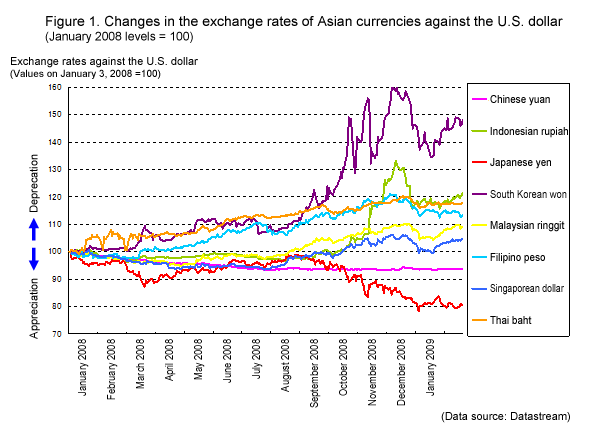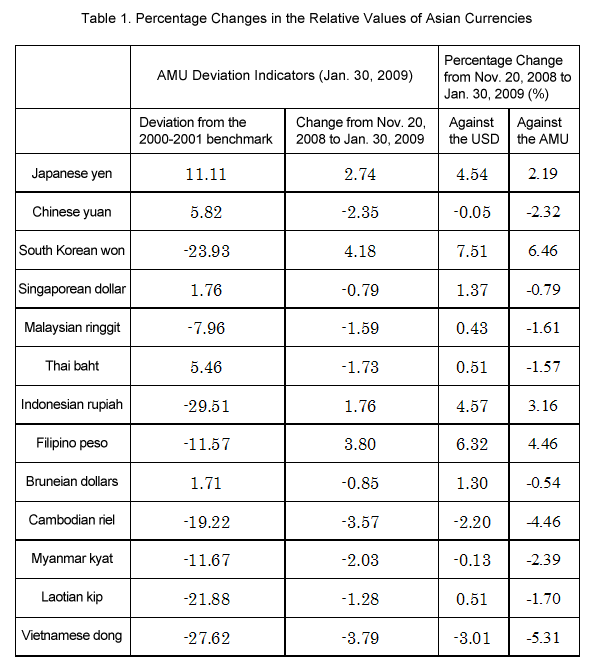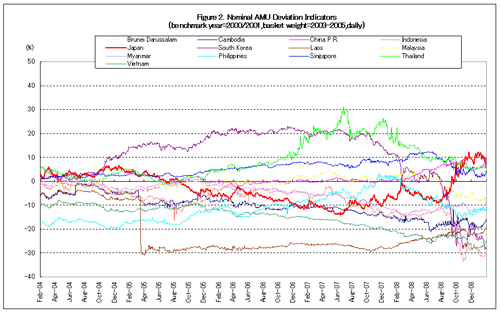This month's featured article
Global Financial Crisis and Asian Currencies - Update

ITO TakatoshiFaculty Fellow, RIETI
Professor, Faculty of Economics and Graduate School of Public Policy, the University of Tokyo
Global Financial Crisis and Asian Currencies
A number of Asian currencies depreciated sharply in the second half of 2008, with the yen being a notable exception. As a result, the balance of power in foreign exchange markets has changed dramatically. The volatility in these markets appears to have settled temporarily with interest rate cuts and relief measures executed for financial markets worldwide following the inauguration of U.S. President Barack Obama on Jan. 20. The deteriorating results of Japanese exporters, which have been cited frequently since the beginning of 2009, clearly illustrate how seriously the international financial crisis and sharply appreciating yen are affecting the real economy. The current situation, however, does not permit us to predict either the magnitude or duration of the deepening recession.
- Enormous differences between appreciating currencies (the yen) and depreciating currencies (such as the Korean won), the sharpness of currency fluctuations, and the comparatively small fluctuations in U.S. dollar-pegged currencies (such as the Chinese yuan) are all characteristics of the exchange rate fluctuations experienced by Asian currencies during this crisis. The following graph shows exchange rate fluctuations relative to the U.S. dollar for major Asian currencies from Jan. 3, 2008 to Jan. 31, 2009. According to the graph, the won depreciated 60% with respect to the greenback through the second half of November 2008, but has since rebounded by approximately 10%. Meanwhile, the difference between the yen, which has maintained its strength, and the won diminished little from the second half of November 2008 to January 31, 2009.
- Fears that were mounting at the end of 2008 of an impending currency crisis have eased now for Asian currencies as their depreciation against the U.S. dollar has leveled off. The accord reached between Japan, China and South Korea in December on expanding the scale of currency swap agreements is believed to have played a major role in stabilizing the won, which had fallen steeply up until that point. Countries in Asia share the view that they must step up the Chiang Mai Initiative and build up the capital of the Asian Development Bank. In these circumstances, it is my opinion that actions are required to encourage greater financial cooperation within Asia and to promptly develop a framework for economic surveillance.
- Studying the AMU Deviation Indicators is useful in this respect. As of January 31, 2009, the indicators were polarized between countries in positive territory and their negative counterparts. The plus countries were Japan, China, Thailand, Singapore and Brunei; minus nations included South Korea and other ASEAN members.
- The table shown above is an updated version of the same table that was used in my December 2008 column. The table shows the extent of fluctuations experienced by Asian currencies from the second half of November 2008, when the South Korean won had depreciated most notably, to the end of January 2009. AMU Deviation Indicators continued to rise for the yen, the strongest currency among Asian Monetary Units (AMUs), which deviated 11.11 points from the benchmark. On the other hand, AMU Deviation Indicators fell to 5.82 points for the Chinese yuan as a result of guidance toward currency depreciation that began at the end of 2008, which caused the spread between the yuan and the yen to increase. AMU Deviation Indicators were in the -20 to -30 range for the won and Indonesian rupiah. The figures have improved slightly from those registered at the low point of last year. Meanwhile, AMU Deviation Indicators have continued to fall for the Malaysian ringgit, Vietnamese dong and Cambodian riel.
- As the global recession has taken on greater proportions, global concerns about potential new policy measures have emerged. For example, competitive interest rate reductions are gaining popularity as a means of reducing exchange rates to protect export-oriented domestic industries during the recession. The global downturn is also raising the possibility that production networks, which have hitherto been growing within Asia, will undergo large-scale restructuring in the future. Large currency fluctuations, not only with respect to the U.S. dollar but also relative to other currencies within the region, are undesirable for Asian countries. The transition to a system that stabilizes currency values within Asia while allowing those values to fluctuate against the U.S. dollar and the euro is essential for determining the economic impact of exchange rate fluctuations on intra-Asian trade, which had been rising in recent years. In that respect AMU Deviation Indicators, which show relative currency values within Asia, play an important role.


Related Article
"Global Financial Crisis and Asian Currencies"
Event Information
Fellow titles and links in the text are as of the date of publication.
For questions or comments regarding RIETI Report, please contact the editor.
*If the "Send by mailer" button does not work, please copy the address into your email "send to" field and connect the prefix and the suffix of the address with an "@", sending it normally.RIETI Report is published bi-weekly.


